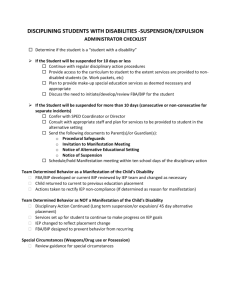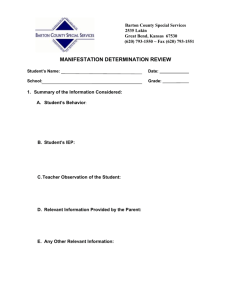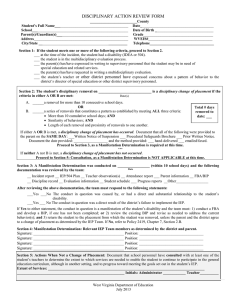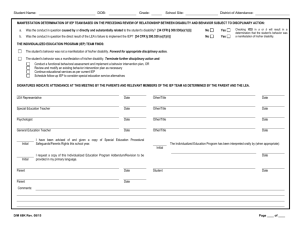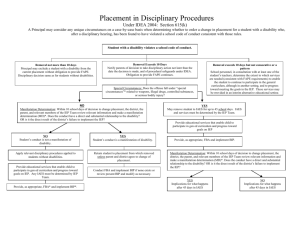Significant Discrepancy in Suspension and Expulsion Rates in West Virginia:
advertisement
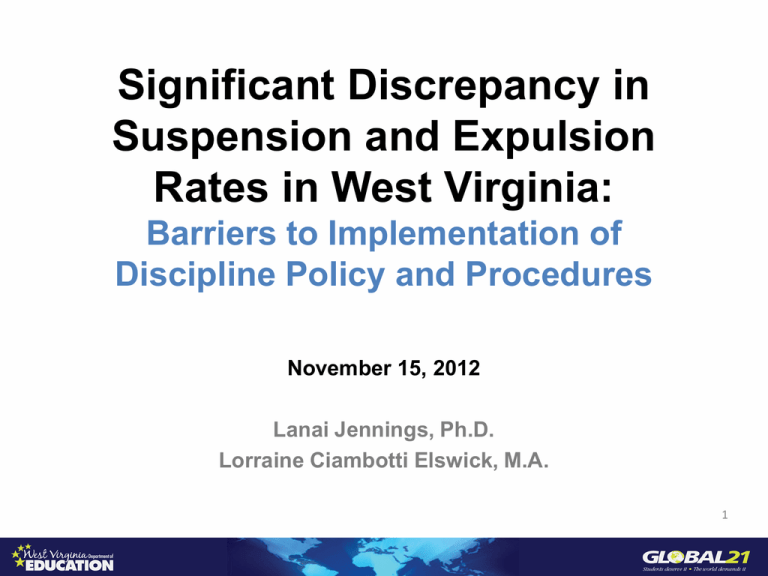
Significant Discrepancy in Suspension and Expulsion Rates in West Virginia: Barriers to Implementation of Discipline Policy and Procedures November 15, 2012 Lanai Jennings, Ph.D. Lorraine Ciambotti Elswick, M.A. 1 Indicator Definitions • Indicator 4A: Are there significant discrepancies in rates of suspension and expulsion (greater than 10 days) for students with disabilities in an LEA as defined by the State established bar? • Indicator 4B: Are there significant discrepancies in rates of suspension and expulsion (greater than 10 days) for students with disabilities by race/ethnicity in an LEA as defined by the State established bar? 2 State Bar / Threshold • Greater than or equal to 3.28 • Basis for state bar 3.28 is two times the rate of the SWD ALL group for 2009-2010 data year Threshold was approved by the West Virginia Advisory Council for the Education of Exceptional Children in December 2011. • Threshold is also important in preventing Significant Disproportionality and 15% set aside of funds 3 Percent of Students with Disabilities with Removals Beyond Ten Days 5.00% 4.00% 3.00% 2.00% 1.00% 0.00% 2009-2010 2010-2011 2011-2012 All SWDs 1.64% 1.34% 1.62% Black SWDs 3.63% 2.95% 3.63% White SWDs 1.53% 1.26% 1.52% Multiracial SWDs 0.52% 0.62% 2.50% 4 Minimum Cell Requirement • 20 or more students with IEPs in the December 1st special education enrollment • All districts meet cell size for Indicator 4A Race/Ethnicity Number of Districts Meeting the Cell Requirement for 4B Asian 1 Black / African American 19 Hispanic 4 White (not Hispanic) 57 Two or more races 7 5 Two Step Process Step 1 • Review data to determine if a significant discrepancy exits – (Slides 2-5) – Excel Workbook Step 2 • Conduct a review of policy, procedures and practices if a significant discrepancy exists 6 Review of Policy, Procedures and Practices Requirement If significant discrepancies exist, do policy, procedures and practices contribute to the discrepancies (i.e., findings of noncompliance relating to the development and implementation of IEPs, the use of positive behavioral interventions and supports and procedural safeguards)(20 U.S.C. 1412(a)(22))? 7 Common barriers to correct implementation of discipline procedures 1. Unreliable data 2. Understanding when a disciplinary change of placement has occurred 3. Lack of documentation of consultation when Not a Change of Placement 4. Same day notice requirements 5. Manifestation determination requirements 6. Addressing the behavior so it does not recur, including use of positive behavioral interventions and supports and other strategies to address the behavior subject to the removal. 8 Discipline and Attendance Data WVEIS Discipline Record Suspension Date 9 Days OSS 8/24/12 1 9/6/12 9 10/2/12 2 WVEIS Attendance Record Date Reason Day Cum. Days 8/24/12 S1 – Out of School 1 1 9/07/12 S1 – Out of School 1 2 9/10/12 S1 – Out of School 1 3 9/11/12 S1 – Out of School 1 4 9/12/12 S1 – Out of School 1 5 9/13/12 S1 – Out of School 1 6 9/14/12 S1 – Out of School 1 7 9/17/12 S1 – Out of School 1 8 10/2/12 S1 – Out of School 1 9 10/3/12 S1 – Out of School 1 10 Disciplinary Change of Placement A Disciplinary Change of Placement Occurs if: 1) the removal is more than 10 consecutive school days; OR 2) the student has been subjected to a series of removals that constitute a pattern because all 3 of the following exist: Series of removals total more than 10 cumulative school days in the year; The student’s behavior is substantially similar to the behavior in previous incidents in the series of removals; and Additional factors such as the length of each removal, the total amount of time the student has been removed, and the proximity of the removals to one another. 10 Example Student Suspension Record Key: Action Code: 24A = OSS Offense Codes: 3B = Disruptive/Disrespectful Conduct 23B = Defacing School Property/ Vandalism 39B = Possession of Illicit Drugs 20B = Profane Language/ Obscene Gesture/ Indecent Act 11 Not a Change of Placement If the current removal is for not more than 10 consecutive school days and is not a change of placement because it does not meet the 3 criteria for a pattern, school personnel, in consultation with at least one of the student’s teachers, must determine the extent to which services are needed to: continue to participate in the general education curriculum, and progress toward meeting the goals set out in the student’s IEP. * This consultation and the services determined must be documented 12 Same Day Notice Requirements When Considering a Disciplinary Change of Placement The district must: 1. Provide same day written notice of the removal 2. Prior Written Notice 3. Procedural Safeguards 13 Manifestation Determination • When the removal is determined to be a change of placement, the district must: – Within ten (10) school days, meet with the parent and relevant members of the IEP Team, to conduct a manifestation determination, – by reviewing all pertinent information in the student’s file, including the student’s IEP, any teacher observations, and any relevant information provided by the parents to determine: 14 Manifestation Determination (cont.) – If the conduct in question was caused by, or had a direct and substantial relationship to the student’s disability; or – If the conduct in question was the direct result of the district’s failure to implement the IEP. If the district, the parent and relevant members of the IEP Team determine that either of the conditions described above were met, the conduct must be determined to be a manifestation of the student’s disability, and the district must take immediate steps to remedy those deficiencies. 15 Results of Manifestation Determination Review • If behavior is not a manifestation of the student’s disability, – May apply relevant disciplinary procedures as with students without disabilities; – Convene IEP Team to develop an IEP to enable student to continue to participate in general ed. curriculum and make progress toward IEP goals (FAPE); and – Provide as appropriate a FBA and behavior intervention services and modifications that are designed to address the behavior violation so that it does not recur. 16 Results of Manifestation Determination Review If behavior is a manifestation of the student’s disability, —Conduct a FBA and develop a BIP, if one has not been developed; —Review the existing BIP and revise as needed to address current behavior; and —Return the student to the placement from which the student was removed unless the parent and the district agree to a change of placement as part of the modification of the BIP as determined by the IEP Team. 17 Addressing the Behavior • IDEA and Policy 2419 require the use of positive behavioral interventions and supports to be considered for: – a student whose behavior impedes his or her learning or that of others, and – when the student’s behavior is not a manifestation of the student’s disability. • FBAs & BIPs are required only when a student’s behavior is determined to be a manifestation of the disability. 18 Addressing the Behavior Policy 4373: Expected Behavior in Safe and Supportive Schools requires the following: The West Virginia Board of Education believes that public schools should undertake proactive, preventive approaches to ensure a positive school climate/culture that fosters learning and personal-social development. These regulations require county boards of education to design and implement procedures to create and support continuous school climate/culture improvement processes within all schools that will ensure an orderly and safe environment that is conducive to learning. 19 Addressing the Behavior • The IEP Team may address behavior through annual goals in the IEP. The student’s IEP may include modifications in his or her program, support for his or her teachers, and any related services necessary to achieve his or her behavioral goals. If the student needs a BIP to improve learning and socialization, the BIP can be included in the IEP and aligned to the goals in the IEP. 20 Resources • Indicator 4 discipline review form • Discipline data from SY 2011-2012 – Basis for Indicators 4A and 4B • Comprehensive discipline training – Hodgin’s PPT from Fall 2012 Leadership • OSEP TA Center on Positive Behavioral Interventions and Supports – http://www.pbis.org/ 21
